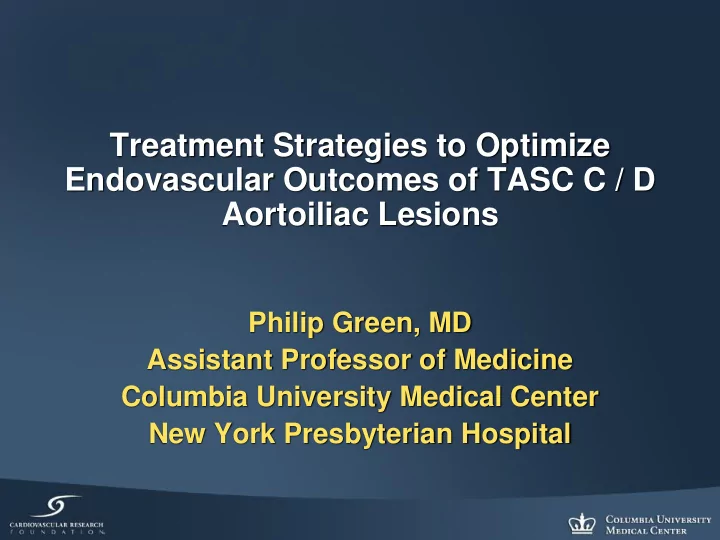

Treatment Strategies to Optimize Endovascular Outcomes of TASC C / D Aortoiliac Lesions Philip Green, MD Assistant Professor of Medicine Columbia University Medical Center New York Presbyterian Hospital
Disclosure Statement of Financial Interest I, Philip Green DO NOT have a financial interest/arrangement or affiliation with one or more organizations that could be perceived as a real or apparent conflict of interest in the context of the subject of this presentation.
Surgical Therapy • TASC II suggests surgical therapy for type C and D lesions. • Surgical options for AIOD are anatomic versus extra-anatomic bypass graft or endarterectomy. 5 year Graft patency • Aortic bifurcation grafts – 90% – 75% 10 yrs • Axillary-unifemoral graft – 51% (44 to 79%) • Axillary-bifemoral bypass - 71% (50 to 76%) • Femoral-femoral crossover graft – 75% (55 to 92%) • Patient comorbidities should be taken into account when considering surgery.
Endovascular Therapy • Single center 43 patient study • “kissing” self -expanding common iliac stents for aorto-iliac bifurcation disease • Primary patency rate of 89%, 82%, and 68% at 2, 5, and 10 years • Secondary patency rates were 93%, 93%, and 86% at 2, 5, and 10 years
Example Kissing Stents
42F with familial hypercholesterolemia, smoker, severe claudication • ABI 0.66 (right) • ABI 0.82 (left) • Peak velocity 383 cm/s left iliac • Peak Velocity 251 cm/s left iliac
Follow Up • Claudication resolved, ABI 0.91/0.95 • Quit smoking • LDL ~40 on Praluent (PCSK9 inhibitor)
COBEST Trial • Randomized, multicenter trial of covered balloon expandable stents vs. other, non-covered stents for iliac artery stenosis • 168 iliac arteries in 125 patients • Included TASC B-D lesions. • Conducted in Australia. Mwipatayi J Vasc Surg 2011;54:1561-1570
Overall Improved Freedom From Restenosis Mwipatayi J Vasc Surg 2011;54:1561-1570
TASC C/D Lesions Mwipatayi J Vasc Surg 2011;54:1561-1570
Five Year Primary Patency of TASC C/D Lesions in the COBEST Trial Mwipatayi J Vasc Surg 2016;64:83-94
Viabahn VBX
• N = 134 patients • 32% with TSC II C or D lesions • 42% kissing iliac stents at aortic bifurcation • 96.9% primary patency at 9 months 95.3% primary patency in TASC C/D Bismuth et al, J Endovasc Therapy 2017;24:629-637
Disadvantages to “kissing” stents • Aortic bifurcations calcification aortic thrombus size or geometric mismatch between the native vessels • The limb competition of two “crossed” kissing stents in a diseased distal aorta can lead to significant flow compromise. • Loss of native bifurcation compromises “up & over” access in the future • Limited options for treatment of more proximal aortic disease in the future
CERAB Technique Figure A During the first step of the CERAB procedure a 12-mm balloon expandable stent is positioned and deployed 15-20mm above the aortic bifurcation Figure B During second step of the CERAB procedure the proximal part of the aortic covered stent is overdilated to adapt to the aortic wall Figure C The CERAB configuration is completed by simultaneous inflation of two iliac covered stents in the conic segment, thereby molding the first one around the latter two
Patient GE • 59 year old woman • s/p CABG • DM2 • Active smoker • Rutherford Class III claudication Severely symptomatic at less than one block No rest pain, no ulcers • L ABI 0.78 • R ABI 0.72
CT • Severe stenosis of the infrarenal aorta. • Right - severe stenosis of the proximal common iliac and proximal external iliac arteries. • Left - moderate to severe stenosis of the proximal common iliac, external and internal iliac arteries.
Angiogram
Intervention Viabahn VBX 8 x 59
Intervention
Intervention Bilateral Viabahn VBX 6 x 59
Intervention Absolute Pro 7 x 60 to both iliacs
Patient GE • 3 months later minimal claudication at 6 blocks
CERAB 3 year outcome data • N=130 • 89% TASC D • 68% claudication • 32% CLI • 67% percutaneous • 30D complication Minor 33% Primary, primary assisted, and secondary patency was 82%, Major 7% 87%, and 97% at 3 years. Taeymans. J Vasc Surg 2018;67:1438-47
57M former smoker • Non obstructive CAD • Carotid stenosis s/p stenting • Right sided claudication with no femoral pulse on exam • CTA showed complete occlusion of right common iliac, external iliac, and common femoral with reconstitution of distal CFA
Left CFA: 18F OD Preclose with perclose x 2 RSFA: 7F
• Claudication completely resolved • Sees me for regular clinical f/u
Treatment of Aortoiliac Occlusive Disease (AIOD) with the Endologix AFX Unibody Endograft T.S. Maldonado et al. Eur J Vasc Endovasc Surg (2016) 52, 64-74
Study Design • 10 center retrospective study conducted between 2012 – 2014 • AFX unibody stent graft (approved for AAA) but used to treat AIOD • AAA (aortic diameter > 3.5 cm) excluded • Outcomes Procedural success 30D mortality Acute complication Rutherford classification / ABI Patency (primary, assisted, secondary)
Patency 2 year patency • Primary 89% • Assisted 97% • Secondary 100%
68M smoker with chronic buttock/thigh claudication with new right calf pain and cool right foot
68M smoker with chronic buttock/thigh claudication with new right calf pain and cool right foot
68M smoker with chronic buttock/thigh claudication with new right calf pain and cool right foot Aorto-Bifem Bypass • Uncomplicated • Discharged po day 5 • Foot warm • No claudication
Conclusions • Treatment of aorto-iliac occlusive disease is evolving • Traditional “kissing stents” & CERAB remain options • The application of dedicated AAA devices to treat AIOD is feasible and provides anatomic advantages • Despite high morbidity aorto-bifemoral bypass surgery remains the gold standard and is still the safest option in select circumstances • Comparative prospective research is needed to solidify the evidence base for AIOD
Recommend
More recommend